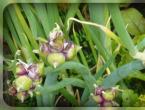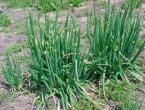Amur lilac smells like honey. Long-lived lilac: everything you need to know to grow luxurious Amur lilac Amur lilac sudarushka growing from seeds
Amur lilac was discovered by Russian botanists R.K. Maak and K.I. Maksimovich in 1855, described by F.I. Ruprecht in 1857. A small tree, sometimes reaching 20 m in height in places of natural growth; in cultivation, it is often a shrub up to 5-8 m high. The bark of older trunks and branches is reddish-brown, shiny, reminiscent of cherry bark. Young shoots are dark gray, glabrous, with light oval lenticels, very thin, mostly arched under the weight of the leaves. The kidneys are small, finely pointed, dark purple or brown. The leaves are on relatively short, thin petioles, ovate, broadly oval, short-pointed, on average 1 cm long and 8 cm wide, bare on both sides, greenish-purple when blooming, or reddish only at the edges. Then they become light green below and darker, matte above.
The inflorescences develop at the ends of short shoots from paired apical buds, large, broadly paniculate, up to 15-20 cm long, diverging at a very obtuse angle, which gives the panicles an openwork, spreading appearance. Flowers with a diameter of 5-8 mm are creamy white, with a honey aroma; in shape, color and aroma they resemble privet flowers, from which the name of the subgenus - ligustrins - comes. Two large anthers rise above the flower on thin filaments. The stigma of the pistil also protrudes from the tubule.
In the conditions of Moscow and the Moscow region, it blooms in the second half of June, sometimes in the first ten days of July, two weeks later. The duration of flowering is 15-20 days. Seed sets well. They are much larger than other species - up to 15 mm long, 6 mm wide. The average weight of 1000 seeds is 15-18 g. They germinate for a long time - three to four months and therefore require stratification.
Area of natural distribution: Far East (Amur region, Primorsky Krai, Kuril Islands); Northeast China, Korea. It occurs on the edges of mixed and deciduous forests and in river valleys. It is quite winter-hardy in the European part of the USSR, it even winters in the Polar-Alpine Botanical Garden on the Kola Peninsula, it is quite drought-resistant, and grows well in deep, aerated soils.
In the conditions of central Russia, freezing of the tops of annual growth was observed only in the most severe winters.
Amur lilac tolerates significant air pollution and is suitable for landscaping not only in summer cottages, but also in roadside areas. Amur lilac is easy to propagate by seeds and green cuttings. It is of interest for landscape and park construction as a highly decorative plant, especially during the flowering period, with a beautiful spreading crown. It grows quickly and is unpretentious in cultivation. Combining it with other species significantly (more than two months) lengthens the overall flowering period of lilacs.
Quite often, Amur lilac is found in botanical gardens and other introduction points. A variety of Amur lilac is Japanese lilac.
Lilac is the most beloved flowering ornamental shrub by Russian residents. In small towns, where everyone is trying to improve their piece of the street in front of their house, more than one lilac bush will definitely be planted. And at the beginning of June, a real riot of lilac blossoms begins. All courtyards are literally buried in white and all shades of lilac flowers, which exude an incomparable scent. This riot of lilac blossoms lasts one to two weeks. One by one, the luxurious inflorescences fade, and the lilac bushes are covered with dirty brown tassels of ripening seeds. True, this won't last long. Growing new shoots will quickly hide the unsightly testes.
After the common lilac, other species of this family bloom. Usually the flowers of these species are smaller than those of the common lilac, and the smell, although pleasant, is still different. But these species of lilacs will decorate a yard or garden plot no worse than the usual lilacs. One of these species is Amur lilac.
If, when designing a site, the choice fell on Amur lilac, then you need to remember that multi-stemmed bushes of this species gain height up to 10 m. And you shouldn’t be deceived by looking at a small two-year-old bush, which even produces very small growth, that this will not happen. In the first years, Amur lilac grows its root system, and the bush remains small and compact. But soon everything will change, and the ten-year-old bush will turn into a powerful, tall and beautiful plant. The thickness of the trunks of this lilac can reach thirty centimeters. This lilac is a long-liver. Her bushes live up to 100 years. Its wood is very strong and hard. In their homeland, this lilac is harvested for firewood, which burns with a loud crackling sound. In the Far East they call it “crackling”. This particular feature – the large height of the bush – must be taken into account when placing it.

In addition to its strength, Amur lilac has one more advantage over ordinary lilacs. If the common lilac remains green in the fall, then the Amur lilac, which has a larger leaf, becomes yellow and all shades of purple, which gives it a special decorative effect. Amur lilac will pick up the flowering of ordinary lilac when the late-blooming varieties have already faded - at the end of June. It blooms for three weeks with large clusters of creamy-white small flowers with a delicate aroma. This lilac is a wonderful honey plant. It does not have fruits, like the common lilac. Its seeds are germinating and can be used to produce new plants. In folk medicine, tinctures are made from faded panicles of this lilac to help with liver diseases and skin diseases. It happens that Amur lilac blooms again in August. There is a varietal Amur lilac - Sudarushka, which retains all the characteristics of the species, but blooms with white flowers with a strong smell of honey.
Lilac hedge video
Lilac is a favorite plant of gardeners. From spring to mid-autumn, it delights with its racemose inflorescences, while spreading the aroma throughout the entire garden. One of the subspecies of these plants is Amur lilac. The primary source about pretty shrubs came from the Amur region, which is why lilac is Amur. It is also called Amur codfish. The old branches of these bushes burn with a characteristic sound and sparks fly several meters to the sides. Habitat: Far East, Primorsky Krai, eastern China and Korea.
Description of the Amur lilac
Amur lilac grows up to twenty meters high. The root system is quite developed, superficial. It can often be found on soils near water bodies, less often on mountain slopes. It blooms with lush buds of light cream color. After wilting, seed pods form. Doesn't bear fruit. The life cycle of the Amur lilac is one hundred years.

Amur lilac is used in garden plots as a hedge. Near reservoirs it plays a soil-strengthening role. It has the property of resisting urban gas pollution, purifying the air. Often used in landscape design.
Selection and preparation of a site
In its natural environment, this species grows in places with a fairly cold climate. So it’s not difficult to grow a bush in the middle zone. But in order for the plant to be beautiful and healthy, you need to know a few rules for caring for it.
The place for the bush should be well lit, without drafts or strong winds. It does not tolerate even slight shading. The soil must be fertile and well permeable.
It is very important that the soil for planting Amur lilacs is loose. In the first year of the plant’s life, the soil is constantly dug up and weeds are removed so that the young bush strengthens faster and more thoroughly. Amur lilacs are planted at the end of summer, when the flowering period ends. So that the plants have time to gain strength before winter.

When planting, you need to dig a hole about fifty centimeters deep. Water generously. If the soil is not fertile enough, the hole is doubled in size and filled with nutritious soil with wood ash. Disembarkation takes place in the late afternoon.
Top dressing
The plant also needs fertilizing. Necessary:
- Phosphorus;
- Nitrogen;
- Magnesium;
- Kaltsy;
- Potassium;
- Manganese;
- Iron;
- Zinc.

Nitrogen fertilizers are applied for the first time in early spring, when there is still snow in places. For better flowering, phosphate fertilizers are applied once every three years.
The use of organic fertilizers (horse and chicken droppings, mullein) promotes the rapid development of this fragrant bush.
Watering, pruning
Watering is an important point when caring for Amur lilac. The bush needs abundant watering in early summer. At the end of the summer season, the amount of water is reduced so that the plant does not die in winter. Watering directly depends on precipitation in the autumn and summer.
Under natural conditions, this shrub looks unsightly. The branches are long and tangled together. To refine the plant, it is trimmed. They form smooth, beautiful bushes. Pruning is done in early spring before buds appear and the plant begins to come to life. Cut off the buds when they fade. All this stimulates the appearance of young shoots with lush flowers.
Reproduction
Amur lilacs are propagated in two ways:
- Seeds;
- Cuttings;

When the buds fade, boxes containing seeds appear. In the fall, cloudy weather is chosen to collect them so that the seeds do not spill out. The boxes are dried and the planting material can be easily removed. To speed up the germination process and increase germination, the seeds are stratified. After two months they can be sown in prepared soil.
Lilacs are successfully propagated by cuttings. In the morning after flowering, young cuttings are cut. Placed in a solution for root stimulation for twenty hours. After planted in the ground.
For slicing, take a sharp grafting knife. Oblique cut. The top of the cutting is cut off. Before planting, rinse the shoots with clean water.
Diseases
Amur lilac suffers from the same diseases as the entire species of lilac:
- Necrosis is a bacterial disease. Wet weather promotes spread. It manifests itself as wilting of the upper parts of the lilac followed by blackening of the leaves;
- Ring spot is a viral disease. Spots and stripes of yellow or light green color appear on the leaves:
- Mosaic - yellow spots of irregular shape form all over the sheet. As the disease progresses, the leaves curl and dry;
- Late blight buds stop developing, the bark and leaf blades become covered with brown spots.

For some diseases there are remedies that can effectively fight them. Bordeaux fluid is used for necrosis. Late blight can also be sprayed with Bordeaux mixture containing copper sulfates. Unfortunately, there are no effective drugs for viral infections yet. Sick bushes with such diseases are subject to destruction. To avoid troubles, you need to use only tested soil, and be sure to disinfect pruning tools.
This fragrant shrub is rightfully called the "Queen of the Garden". It will thank you for your care and love with lush and dense flowering and will bring joy to people for many years.
In spring, when nature enters the warm season and everything around comes to life and blooms, one of the most attractive and fragrant shrubs blooms. We are talking about lilacs.
Mostly flowering occurs in May, or, to be more precise, in the middle of this spring month. Lilac is famous for its attractive appearance and medicinal properties.
Flowering occurs in about 20 days . However, there are exceptions. For example, varieties of josé and boomerang can bloom several times over 12 months.
Often this tree serves to make summer cottages attractive. But it has a special place in medicine.
Medicinal properties
Experts have already studied the benefits of this type and with great pleasure use this plant for treatment.
- make tinctures
- herbal teas
- make compresses
 For these purposes, buds that have not yet blossomed are collected. Lilac can also lower blood sugar.
For these purposes, buds that have not yet blossomed are collected. Lilac can also lower blood sugar.
Imagine, that flowers can save a person from gastrointestinal disorders, malaria and even rheumatism. A herbal infusion is used for diabetes and stomach ulcers.
The prepared decoction will help boost immunity and defeat ARVI. Lilac also helps for healing and will save you from nervous disorders.
Not only the flowers of this plant, but also the bark has medicinal properties. For example, a decoction prepared from it help with dermatitis. Doctors recommend wiping problem areas of the skin with this tincture. It also helps with joint pain and osteochondrosis.
Where does it grow
This shrub has almost 30 different types and about 1.5 thousand hybrids in its genus. They are all bright and terry, however, they differ in size and at the time of year when the flowers bloom.
The Amur type is a beautiful and at the same time decorative tree. It grows mainly in the following places:
- Far East
- China
- Korea
- Primorsky Krai
- Amur region
The tree is not only decorative, but also soil strengthening.
Lilacs often prefer to grow on mountain slopes and in forested areas. Experiments and breeding with this plant began back in the 19th century. From that moment on, many different varieties of this tree began to be developed.
The Amur variety is also called a long-lived plant. In one area it can grow for a hundred years.
Amur lilac: characteristics and description
 The Amur type refers to a deciduous multi-stemmed shrub. It can grow up to 10 meters. It has a luxurious crown, especially after shaping.
The Amur type refers to a deciduous multi-stemmed shrub. It can grow up to 10 meters. It has a luxurious crown, especially after shaping.
The Amur variety also has a subspecies - codfish.
In the first year when the tree was planted, the shrub grows at a slow pace. Young shoots are almost never formed.
During this period, all the efforts of the seedling are aimed at forming the root system of the tree. At first it is shallow, however, after two or three years, the roots become deeper.
After some time, growth becomes more intense. When the bush reaches the age of 10 years, a small bush becomes a beautiful tree. The grown trunks are strong and have a diameter of more than 30 centimeters.
Type characteristic:
- rich gray bark
- The wood is light and quite heavy
- younger shoots are reddish in color and look like cherry branches
 They are very often used for fuel. When they burn, they make a crackling sound, and sparks fly in different directions over a distance of a meter or more.
They are very often used for fuel. When they burn, they make a crackling sound, and sparks fly in different directions over a distance of a meter or more.
But the leaves of the Amur variety are exactly the same as those of other species of this plant. They have a rich green color and have a regular ellipse shape. The size of the leaves is large. They grow up to 11 centimeters in length.
Lilac in autumn does not change the color of the foliage, but the Amur, on the contrary, changes color and colors.
Characteristics and descriptions of this type of tree are found in almost all publications and specialized literature for gardeners.
In autumn, this tree blooms and turns into a beautiful and flowering bush. The leaves turn purple and golden-orange.
This species has a number of differences from the classic lilac variety in the flowering period.
"Crackle" blooms at the end of June for about 3 weeks
The Amur species "Crackle" has small flowers. They reach about 6 millimeters in diameter.
- flowers have 4 petals
- have distinct stamens
- flowers are collected in large inflorescences, the so-called panicles
 They grow on the tips of young shoots in considerable numbers. Almost completely cover this beautiful shrub.
They grow on the tips of young shoots in considerable numbers. Almost completely cover this beautiful shrub.
Flowers can be light, delicate tones: white or cream. They emit a pleasant subtle scent.
They use it to lure pollinators and are the best honey plant.
Amur lilac does not bear fruit. The buds that have bloomed produce seeds. With their help, you can plant and soon get new seedlings.
In order for the bush to bloom more widely and densely in the next period, the panicles that have dried out must be torn off.
In the future, they can be used for medicinal purposes. For example, make a water decoction or alcohol tincture.
Planting the Amur species of lilac
Amur-type lilacs are not at all a curiosity in garden plots. It's quite common. Planting and caring for this plant is quite simple.
This species simply loves the sun. Therefore, it is better to choose a place where the sun's rays fall. The only thing, lilacs should be protected from strong gusts of wind and drafts.
Gardeners should ensure that the area where Amur lilac is planted has good drainage. Also, in the spring there should be no flooding, when snow and ice begins to melt, as well as in the autumn during heavy rains.
Under no circumstances should there be stagnation of liquid, even for a short period of time. After all, this can lead to the roots deteriorating and dying.
Amur lilac is an unpretentious plant in planting and care, however, there are some features that should be taken into account.

If the soil is acidic, it should be limed. In the case where the soil has a clayey and heavy structure, you can add sand.
If there is groundwater nearby, a drainage system is required.
Before planting the Amur variety in planting holes, it is necessary to place compost, humus or superphosphate in them.
If the planting material is in containers, you can plant it at any time.
However, this does not mean that the Amur type does not need care. Against. From time to time it is necessary to pull out the weeds and loosen the soil around the trunk.
Weeds are dangerous for this plant. Especially for a young tree. After all, the roots are still close to the surface of the earth.
The following weeds can adversely affect the growth of this tree: wheatgrass, dandelion and gooseberry. It is necessary to loosen the soil to supply more oxygen and moisture to the root system of Amur lilac.
In the first summer months, Amur lilacs need to be watered abundantly. For 1 square meter about 30 liters. If there is precipitation during this period, the amount of watering can be reduced.













Amur lilac is one of the types of lilac, which is used not only for decorating the garden, but also as a bank and soil strengthening material. The tree received its second name “Crackling” because of the crackling noise emitted by burning damp wood; sparks can fly several meters away.
- Phosphorus
- Potassium
- Calcium
- Magnesium
- Iron
- Manganese
- Molybdenum
- Cobalt
Nitrogen fertilizers can be given already in the second year of development. This is done in the form of three feedings of 50 grams per season, or ammonium nitrate is used in the amount of 70 grams.
The first fertilizing is done a month after the soil has thawed; you don’t even have to wait until the snow has completely melted. The second and subsequent ones in 3 weeks.
Some of the most valuable fertilizers are horse manure, chicken manure and mullein.
Ash is used as a complex fertilizer. It is taken from dried or cut branches.
Much attention is paid to the formation of the bush; pruning is done already from the 3rd year of the plant’s life. The main trunks should remain those branches that lengthen the bush. Shoots going deep into the crown are completely cut off.

Amur lilac can be propagated both for the development of your own garden and for sale.
The main methods of propagating a bush:
- Seeds
- Cuttings
- By layering
- Vaccination
Seeds are collected in late autumn in wet weather, so the seeds do not spill out of the box.
To stratify the seeds, they are mixed with wet river sand in a ratio of 1:3 and left in any container with holes for water drainage. The jar or box should be kept in a room with a temperature of no more than +5 degrees. The bottom of the refrigerator is suitable for this purpose.
After 2 months, the seeds are sown in a box with steamed soil.
If you take homogeneous, unprepared soil, the seeds will not germinate. When propagated by layering, young seedlings can be obtained by autumn.
The most common layers are simple, Chinese and Dahlem:
- With simple retraction, the branches of the bush are bent to the ground and secured with pegs.
- With Dahlem, young shoots are tied with copper wire to stimulate root formation.
- The Chinese method resembles a simple one: the shoots are bent to the ground, previously tied with wire.
To grow a rootstock, ash or privet, sometimes Hungarian lilac, are most often taken. The best fusion of scion and rootstock is ensured in plants of the same species.
Grafting Amur lilac is no different from grafting other trees or shrubs. A simple copulation is used, with a tongue, grafting behind the bark, into the cleft and with an eye.
You can find out more information from the video.




